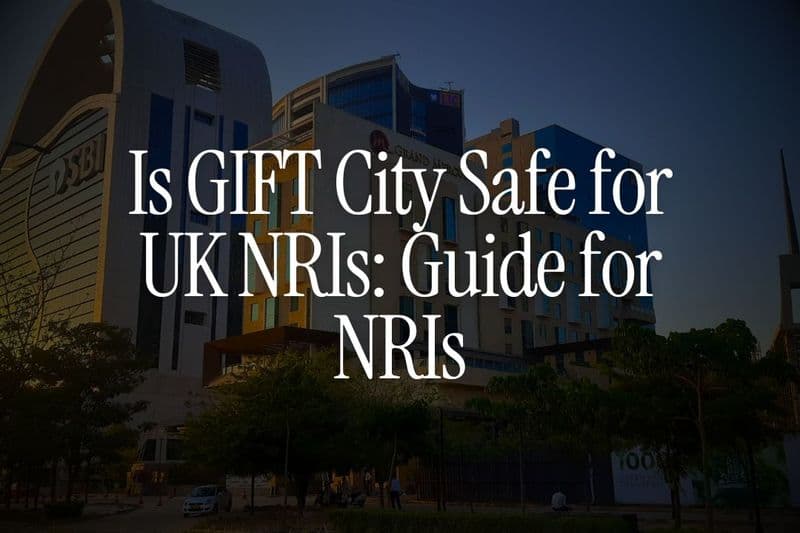
Three months ago, Sameer sent us a message from Dubai at 2 AM: "I've been working 60-hour weeks for eight years.
My savings are just sitting in a 0.5% UAE bank account. I want my money to work while I sleep. Where do I even start?"
We sat down with Sameer over video call. Together, we built a passive income plan. Today, he earns ₹78,000 monthly from six different income streams in India - while still working his Dubai job.
That's ₹9.36 lakhs annually in money that shows up whether he's in a meeting, on vacation, or asleep.
The best part? He started with just ₹15 lakhs and added ₹50,000 every quarter.
At Belong, we've helped over 600 UAE-based NRIs like Sameer build passive income portfolios. Through our app and WhatsApp community, we've learned what works - and what doesn't - when you're earning in dirhams but want your money working in India.
This guide covers nine proven income streams you can build from the UAE. We'll show you exact returns, tax implications, minimum investments, and how to start each one. No fluff. No made-up numbers. Just strategies we've tested with real clients.
By the end, you'll have a clear map for building ₹50,000 to ₹2 lakhs in monthly passive income - depending on your capital and risk appetite.
Let's start with the question everyone asks but few answer honestly.
What "Passive Income" Really Means for NRIs (And What It Doesn't)
Let's be clear: truly passive income - money that requires zero effort after setup - barely exists.
Even "passive" investments need:
- Initial research and setup (days to weeks)
- Annual tax filing in India
- Periodic rebalancing (quarterly or yearly)
- Tracking exchange rates if you're converting
What passive income actually means: You earn money without trading your time directly for it. You're not billing by the hour. You're not present at work. The income flows from assets you own - not labor you perform.
For UAE-based NRIs, passive income strategies must also be:
1. Tax-efficient: You don't want 30% TDS eating your returns
2. Repatriable: You should be able to move money back to UAE if needed
3. Compliant: No FEMA violations or unreported foreign assets
4. Low-maintenance: You can't fly to India every quarter to manage it
The nine ways we're covering today meet all four criteria.
According to RBI data, NRI deposits and investments in India crossed $140 billion in 2024. But less than 18% of that is actively generating regular income. Most sits in savings accounts or one-time FDs earning 3-6% with no monthly cash flow.
We're going to change that for you.
👉 Tip: Before building passive income, ensure you have 6-12 months of expenses in an emergency fund. Passive income investments should be with surplus capital - not money you need next month.
Way #1: GIFT City USD Fixed Deposits (The Foundation Everyone Should Start With)
If you're reading this and haven't built any passive income yet, start here.
Why This Is the Best First Step
GIFT City USD fixed deposits give you:
- Monthly or quarterly interest payouts (you choose)
- 4-5% annual returns in USD (as of October 2025)
- Zero tax in India or UAE
- Full repatriation anytime
- Zero currency risk (your money stays in dollars)
Real Example: Building Your First Income Stream
Capital invested: $25,000
Interest rate: 4.5% annually
Tenure: 2 years (but you can choose 3 months to 10 years)
Interest payout: Quarterly
Quarterly income: $25,000 × 4.5% ÷ 4 = $281.25
In AED (at 3.67 exchange rate): ₹1,032 per quarter
Monthly equivalent: AED 344 (₹8,300 INR)
That's your first passive income stream - deposited directly to your bank account every three months without you doing anything.
Tax Treatment
In India: Zero tax under IFSC regulations
In UAE: Zero income tax
Result: You keep 100% of the 4.5%
Compare this to NRE FDs earning 6.5% in rupees:
- If rupee depreciates 3% annually, real USD return = 3.5%
- After adjusting for currency risk, GIFT City's 4.5% is actually better
How to Start
- Download Belong app
- Complete digital KYC (10 minutes)
- Wire transfer USD from your UAE bank
- Choose your FD tenure and payout frequency
- Interest starts flowing to your account
Minimum: $1,000
Ideal starting amount: $10,000-25,000
According to ICICI Bank GIFT City data, the average NRI investor deposits $18,000 initially and adds to it quarterly.
Who should use this: Everyone. This is your foundation. Even if you eventually build other income streams, keep 30-40% of your passive income portfolio here for stability.
Read more: GIFT City vs NRE vs NRO FDs Compared
Way #2: Dividend Stocks (Blue-Chip Dividend Aristocrats)
Once you have your GIFT City foundation, dividend stocks are the next logical step.
How It Works
You buy shares of profitable Indian companies that distribute a portion of profits to shareholders as dividends. Unlike FDs where interest is fixed, dividends can grow over time as companies become more profitable.
The Smart Approach: Dividend Aristocrats
Don't chase 8-10% dividend yields from unknown companies. They're risky. Instead, focus on "dividend aristocrats" - companies that have paid consistent or growing dividends for 10+ years:
Examples (October 2025 dividend yields):
- ITC Limited: 5.8% yield
- Coal India: 7.2% yield
- NTPC: 4.5% yield
- Power Grid Corporation: 4.8% yield
- Oil & Gas Corporation (ONGC): 6.5% yield
Real Example: Building a Dividend Portfolio
Capital: ₹10 lakhs split across 5 stocks
Average dividend yield: 5.5%
Annual dividend income: ₹10,00,000 × 5.5% = ₹55,000
Quarterly: ₹13,750
Monthly equivalent: ₹4,583
Most companies pay dividends quarterly or annually. You spread across different companies with different payout schedules to create more regular cash flow.
Tax Treatment for UAE-Based NRIs
Dividends from Indian companies are taxed at 20% + surcharge + cess for NRIs, according to Income Tax Act Section 115A.
Effective tax: 20% (if dividend is under ₹50 lakhs)
From ₹55,000 dividend:
- Tax: ₹11,000
- Net income: ₹44,000 annually (₹3,667/month)
👉 Tip: Use your India-UAE DTAA benefits. File Indian tax returns with your UAE Tax Residency Certificate to potentially reduce this rate.
Capital Appreciation Bonus
Unlike FDs, your principal can grow. If your ₹10 lakh portfolio appreciates 10% annually, you gain ₹1 lakh in capital value plus ₹44,000 net dividend income.
How to Start
You'll need:
- NRI Demat account with PIS (Portfolio Investment Scheme)
- NRE/NRO bank account linked to your Demat
- Indian PAN card
Platforms like Zerodha, ICICI Direct, or HDFC Securities offer NRI accounts.
Steps:
- Open Demat account (2-3 days online)
- Fund via NRE account
- Research dividend aristocrats (use Screener.in or Tickertape)
- Buy shares in multiples of 100 for better pricing
- Set up automatic dividend credit to your NRE/NRO account
Minimum: ₹50,000
Ideal: ₹5-10 lakhs for diversification
According to SEBI data, NRI investment in Indian equities has grown 23% annually since 2020.
Risk level: Medium (stocks can fluctuate 10-30% in value)
Best for: Investors comfortable with volatility who want growing income over time
Way #3: Debt Mutual Funds with Systematic Withdrawal Plans
Here's a strategy most NRIs don't know about: You can create your own "dividend" from mutual funds.
How It Works
You invest in debt mutual funds (low-risk funds investing in bonds and government securities). Instead of waiting for dividends, you set up a Systematic Withdrawal Plan (SWP) - instructing the fund to sell a fixed amount of units every month and send you cash.
Why This Is Tax-Smart
Interest from FDs: Taxed as regular income
Dividends from stocks: 20% tax
SWP from debt funds: Mix of capital gains (taxed at lower rates) and capital return (not taxed)
Real Example
Capital: ₹25 lakhs in a corporate bond fund
Expected fund return: 7.5% annually
Monthly SWP: ₹15,000
Annual withdrawal: ₹1,80,000
Fund growth: ₹25,00,000 × 7.5% = ₹1,87,500
Your fund grows by ₹1,87,500 but you withdrew ₹1,80,000 - so your capital stays intact. The ₹7,500 extra compounds for future growth.
Tax Treatment
Of your ₹15,000 monthly SWP:
- ~₹13,500 is return of your own capital (not taxable)
- ~₹1,500 is capital gains (taxed at your slab rate if \<3 years, or 20% with indexation if \>3 years)
Effective tax on ₹1,80,000 annual withdrawal: ₹3,600-5,400 (much lower than FD or dividend tax)
How to Start
- Open mutual fund account with AMC or platform (Groww, Kuvera)
- Complete NRI KYC
- Invest lump sum in debt funds (corporate bond funds or banking & PSU funds)
- Set up monthly SWP after 1 year (to avoid exit loads)
Best debt funds for SWP:
- ICICI Prudential Corporate Bond Fund
- HDFC Corporate Bond Fund
- Aditya Birla Sun Life Corporate Bond Fund
According to AMFI data, debt fund average returns over 5 years have been 6.8-7.5% for quality funds.
Minimum: ₹5 lakhs
Ideal: ₹15-25 lakhs
Best for: NRIs who want monthly cash flow with lower tax than FDs or dividends
Read more: How to Invest in Mutual Funds as an NRI
Way #4: Real Estate Investment Trusts (REITs)
Don't want to buy property but want real estate income? REITs let you own a piece of commercial buildings - offices, malls, warehouses - and earn rental income without being a landlord.
How REITs Work
REITs in India own and operate income-generating properties. They collect rent from tenants (companies like Flipkart, Microsoft, JP Morgan) and distribute 90% of profits to investors as dividends.
You buy REIT units on the stock exchange just like shares.
Current Indian REITs (October 2025)
REIT Name | Dividend Yield | Price per Unit |
|---|---|---|
Embassy Office Parks | 6.8% | ₹385 |
Mindspace Business Parks | 6.2% | ₹320 |
Brookfield India REIT | 7.1% | ₹295 |
Nexus Select Trust (retail) | 5.9% | ₹125 |
Real Example
Investment: ₹5 lakhs in Embassy Office Parks REIT
Units bought: 1,299 units (at ₹385/unit)
Dividend yield: 6.8%
Annual dividend: ₹5,00,000 × 6.8% = ₹34,000
Quarterly payout: ₹8,500
REITs pay dividends quarterly - so you get ₹8,500 every three months deposited to your Demat account.
Tax Treatment for NRIs
Dividends from REITs are taxed at slab rates (not the flat 20% like regular stocks) according to Income Tax regulations.
For NRIs with only India-sourced income:
- If your total India income (including REIT dividends) is under ₹5 lakhs, effective tax is ~10-15%
- 10% TDS deducted if dividend exceeds ₹5,000 annually
From ₹34,000 dividend:
- TDS deducted: ₹3,400
- You receive: ₹30,600
- Net monthly income: ₹2,550
You can claim refund when filing ITR if your effective rate is lower.
Capital Appreciation
REITs also appreciate. Embassy Office Parks started at ₹300 (2019) and trades at ₹385 (2025) - 28% gain plus all dividends collected.
👉 Tip: REITs offer better liquidity than physical property. You can sell units on the stock exchange in seconds - try selling a flat that fast.
How to Start
- Open NRI Demat account with PIS permission
- Fund via NRE/NRO account
- Place buy order for REIT units on NSE/BSE (like buying stocks)
- Dividends automatically credit to your linked bank account
Minimum: ₹50,000 (about 130-170 units depending on REIT)
Ideal: ₹3-5 lakhs for meaningful dividend income
According to NSE data, REIT trading volumes have grown 145% since 2022 as more retail investors discover them.
Risk level: Medium (REIT prices can fluctuate 15-25%)
Best for: NRIs who want real estate exposure without property hassles
Read more: REITs vs Physical Real Estate for NRIs
Quick Progress Check: First Four Income Streams
At this point, if you deployed capital across these four streams:
Stream | Capital | Monthly Income | Tax | Net Monthly |
|---|---|---|---|---|
GIFT City USD FD | $25,000 | $112.50 | Zero | ₹8,582 |
Dividend Stocks | ₹10 lakhs | ₹4,583 | 20% | ₹3,667 |
Debt Fund SWP | ₹25 lakhs | ₹15,000 | Low | ₹13,500 |
REITs | ₹5 lakhs | ₹2,833 | 10% | ₹2,550 |
Total | ~₹75 lakhs | ₹28,299/month |
That's ₹3.4 lakhs annually in passive income from a ₹75 lakh investment - 4.5% post-tax yield with diversification across four uncorrelated assets.
Now let's add five more income streams to potentially double or triple this.
Way #5: Infrastructure Investment Trusts (InvITs)
Think of InvITs as REITs for infrastructure - toll roads, power transmission lines, gas pipelines, telecom towers.
Why InvITs Are Attractive
Stable, contracted cash flows: Most InvIT assets have 20-30 year contracts with government or large corporates. Revenue is predictable.
Higher yields than REITs: InvITs typically yield 7-9% because they're less known and infrastructure is perceived as boring (which actually means stable).
Current InvITs (October 2025)
InvIT Name | Yield | Focus Area |
|---|---|---|
IRB InvIT | 8.2% | Toll roads |
India Grid Trust | 7.8% | Power transmission |
PowerGrid InvIT | 7.5% | Electricity infrastructure |
Brookfield India Infrastructure | 8.5% | Gas pipelines, toll roads |
Real Example
Investment: ₹8 lakhs in India Grid Trust
Units: 800 (at ₹1,000/unit)
Yield: 7.8%
Annual distribution: ₹8,00,000 × 7.8% = ₹62,400
Quarterly: ₹15,600
Monthly equivalent: ₹5,200
Tax Treatment
InvIT distributions have three components:
- Interest income: Taxed at slab rates (10-30% for NRIs)
- Dividend: Taxed at slab rates
- Return of capital: Not taxed
Typically, 60-70% of InvIT payout is interest, 20-30% is dividend, 10% is return of capital.
Effective tax on ₹62,400: ~₹12,500-15,600 (20-25% effective rate)
Net income: ₹47,000-50,000 annually (₹3,900-4,167/month)
According to SEBI InvIT regulations, InvITs must distribute 90% of cash to investors, similar to REITs.
How to Start
Same as REITs - buy through your NRI Demat account on stock exchanges.
Note: InvIT minimum lots are typically larger (₹1 lakh to ₹10 lakhs at IPO stage, but tradeable in smaller amounts on secondary market).
Minimum: ₹1 lakh
Ideal: ₹5-10 lakhs
Risk level: Medium-Low (infrastructure assets are stable, but unit prices can fluctuate)
Best for: Income-focused investors who want higher yields than REITs with predictable cash flows
Way #6: Rental Income from Indian Property
The classic passive income stream - but only if you set it up right.
The Honest Truth About Rental Property
Rental income is not truly passive. You'll deal with:
- Tenant screening and management
- Repairs and maintenance
- Vacancy periods
- Property tax and society charges
But if you're willing to hire a property manager (2-10% of rent), it becomes semi-passive.
Real Example: Rental Property Math
Property: 2BHK in Pune (Hinjewadi IT corridor)
Purchase price: ₹65 lakhs
Monthly rent: ₹35,000
Annual rental income: ₹4,20,000
Expenses:
- Property manager (5%): ₹21,000
- Property tax: ₹8,000
- Maintenance/repairs: ₹15,000
- Net rental income: ₹3,76,000 (₹31,333/month)
Rental yield: 5.8% (₹3,76,000 ÷ ₹65,00,000)
Tax Treatment for NRIs
Rental income is taxed under "Income from House Property" with special rules:
Standard deduction: 30% of gross rent (for repairs, even if you don't spend it)
Tenant must deduct TDS: 31.2% on rent paid to NRI landlords
From ₹35,000 monthly rent:
- Tenant pays you: ₹24,080 (after TDS)
- TDS deducted: ₹10,920
You file Indian tax return and claim:
- Gross rent: ₹4,20,000
- Less 30% standard deduction: ₹1,26,000
- Taxable income: ₹2,94,000
- Tax at 30%: ₹88,200
You already paid ₹1,31,040 as TDS - so you get ₹42,840 refund.
Final tax: ₹88,200 (20% effective rate on gross rent)
Net after-tax income: ₹3,31,800 annually (₹27,650/month)
👉 Tip: Claim Section 54/54F exemptions if you sell property and reinvest in another - you can defer capital gains tax.
How to Start
- Buy property in high-rental-demand areas (IT hubs, tier-1 cities near metros/offices)
- Hire property manager from day 1
- Screen tenants carefully (ask for employment proof, past landlord references)
- Open NRO account specifically for rental income (keeps it separate for tax filing)
- File Indian tax returns annually to claim TDS refunds
Minimum: ₹40-50 lakhs (property cost)
Rental yield: 4-7% depending on city and property type
According to ANAROCK Property data, rental yields in Indian metro cities average 2.5-4% for residential, 6-8% for commercial.
Risk level: Medium-High (illiquid asset, tenant risk, maintenance hassles)
Best for: NRIs who eventually plan to return to India and want a property they can use, or those with family in India who can oversee it
Read more: Real Estate Rules for NRIs
Way #7: GIFT City Alternative Investment Funds (Debt-Focused)
For those with larger capital (₹1.5 crores+), GIFT City AIFs offer institutional-grade income streams.
How GIFT City AIFs Work
These are privately pooled funds investing in:
- Structured debt (corporate loans with collateral)
- Real estate debt (construction finance with property backing)
- Infrastructure debt (roads, power projects)
They're like high-grade bond funds but with professional management and higher minimums.
Real Example
Investment: $150,000 (~₹1.26 crores) in a Category II debt AIF
Expected return: 9-11% annually in USD
Distribution: Quarterly
Annual income: $150,000 × 10% = $15,000
Quarterly: $3,750
Monthly equivalent: $1,250 (₹30,188 in INR)
Why The Returns Are Higher
Illiquidity premium: You lock in for 3-5 years - so you earn extra return
Credit analysis: Professional managers pick debt deals you can't access individually
Diversification: One AIF might hold 15-20 different debt instruments
Tax Treatment
GIFT City AIFs enjoy favorable tax treatment under IFSC regulations:
- Interest/income distributions are tax-free in India
- Capital gains at exit taxed at preferential rates
Net income: Keep 100% of distributions (no tax in India or UAE)
How to Start Through Belong
- Contact us for AIF access (minimum $150K)
- We connect you with fund managers
- Complete KYC and risk assessment
- Wire transfer USD to fund
- Quarterly distributions begin after first quarter
According to IFSCA data, GIFT City AIFs have grown 340% since 2021 with NRIs comprising 65% of investors.
Minimum: $150,000
Lock-in: 3-5 years
Ideal for: HNWIs seeking higher income with managed risk
Risk level: Medium (credit risk if borrowers default, but mitigated by professional management and diversification)
Read more: Complete Guide to GIFT City AIFs
Way #8: Corporate and Government Bonds
Bonds are loans you give to companies or the government. They pay you fixed interest until maturity, then return your principal.
Types of Bonds for Income
Government bonds: Safest, lowest yield (6.5-7.5%)
PSU bonds: (State-owned companies) Safe, 7.5-8.5%
AAA corporate bonds: (Top companies) 8.5-9.5%
AA/A corporate bonds: Higher risk, 9.5-11%
Real Example: Bond Portfolio
Capital: ₹20 lakhs split across:
- ₹8 lakhs in Government of India bonds (7.2%)
- ₹7 lakhs in NTPC bonds (8.5%)
- ₹5 lakhs in HDFC bonds (8.8%)
Weighted average yield: 8.1%
Annual interest: ₹20,00,000 × 8.1% = ₹1,62,000
Semi-annual payouts: ₹81,000
Monthly equivalent: ₹13,500
Tax Treatment
Bond interest is taxed at slab rates for NRIs.
From ₹1,62,000 interest:
- Tax at 30% (if no other India income): ₹48,600
- Net income: ₹1,13,400 (₹9,450/month)
👉 Tip: Consider tax-free bonds from NHAI, REC, or PFC (National Highways Authority, Rural Electrification Corporation, Power Finance Corporation). Interest is tax-free in India for everyone including NRIs.
Tax-free bond yield: 5.5-6% (lower but tax-free equals 7.8% taxable equivalent for 30% bracket)
How to Buy Bonds
Primary market (new issues):
- Watch for bond IPOs on NSE/BSE
- Apply through your Demat account
- Hold till maturity for fixed income
Secondary market (existing bonds):
- Buy bonds trading on exchanges
- Prices fluctuate based on interest rates
- Can sell before maturity if needed
Platforms: NSE Bond Platform, BSE Bond Platform, brokers like Zerodha
Minimum: ₹10,000 per bond (but buy ₹2-3 lakhs minimum for meaningful income)
According to RBI bond market data, corporate bond issuance grew 28% in FY 2024-25.
Risk level: Low (Government bonds) to Medium (Corporate bonds - check credit rating)
Best for: Conservative investors wanting predictable, fixed income
Way #9: Business Lending Through P2P Platforms (High Risk, High Return)
This is the highest-risk option on our list, but also potentially the highest return for income.
How P2P Lending Works
Peer-to-peer lending platforms (regulated by RBI) match lenders (you) with borrowers (individuals/small businesses). You earn interest on loans.
RBI-registered platforms: Faircent, LenDenClub, Liquiloans
Real Example
Capital deployed: ₹10 lakhs across 100 borrowers (₹10,000 each)
Platform: Faircent
Expected return: 12-18% annually
Conservative estimate (12%):
Annual interest: ₹1,20,000
Monthly: ₹10,000
Realistic with some defaults:
Default rate: 5-8% (industry average)
Net return: 10-13%
Actual monthly income: ₹8,300-10,800
Tax Treatment
Interest from P2P lending is taxed at slab rates (30% for most NRIs).
From ₹1,00,000 net interest (after defaults):
- Tax: ₹30,000
- Net income: ₹70,000 annually (₹5,833/month)
The Risk Reality Check
P2P is the riskiest option we've listed. Some borrowers will default. Platforms minimize this through:
- Credit scoring
- Diversification (your ₹10L spread across 100 loans)
- Collections process
But you will lose some money. Budget for 5-10% principal loss over time.
How to Start
- Check if platform accepts NRIs (most do)
- Complete KYC with Indian PAN and address proof
- Link NRO account (P2P income must go to NRO)
- Start with ₹1-2 lakhs to test
- Auto-invest feature distributes across multiple loans
Minimum: ₹50,000
Recommended: Don't allocate more than 5-10% of total passive income capital here
According to RBI P2P regulations, individual lenders are capped at ₹50 lakhs total across all P2P platforms.
Risk level: High (borrower default risk, platform risk)
Best for: Aggressive investors with diversified portfolios seeking higher yields who can afford losses
⚠️ Our take: We don't typically recommend P2P as a core passive income source. If you use it, keep it under 10% of your portfolio and view it as "yield booster" not foundation.
Real Case Study: Priya's Multi-Stream Passive Income Portfolio
Priya, 41, works in Abu Dhabi in HR. She wanted to build ₹1 lakh monthly passive income before retiring in 5 years.
Starting capital (2023): ₹82 lakhs
Monthly additions: ₹75,000
Her Allocation (Year 1)
Stream | Capital | Monthly Income | Notes |
|---|---|---|---|
GIFT City USD FD | $40,000 | $150 (₹11,475) | Foundation, zero tax |
Dividend stocks | ₹15 lakhs | ₹5,500 (net) | 5 blue-chips |
Debt fund SWP | ₹28 lakhs | ₹16,000 (net) | 3 funds |
REITs | ₹6 lakhs | ₹3,000 (net) | Embassy + Mindspace |
InvITs | ₹9 lakhs | ₹5,600 (net) | India Grid |
Rental (Pune flat) | ₹24 lakhs | ₹18,000 (net) | 2BHK managed |
Total Year 1 | ₹82L + $40K | ₹59,575 |
She wasn't at ₹1 lakh yet - but she had six income streams flowing.
Year 2-3: Compounding and Adding
- Reinvested 60% of passive income
- Added ₹75,000/month from salary
- Increased GIFT City to $80,000
- Added second rental property in Bangalore (₹28 lakhs)
- Moved ₹10 lakhs into InvITs
Current Portfolio (October 2025)
Stream | Capital | Monthly Income |
|---|---|---|
GIFT City USD FD | $80,000 | $300 (₹22,950) |
Dividend stocks | ₹22 lakhs | ₹7,900 |
Debt fund SWP | ₹35 lakhs | ₹20,000 |
REITs + InvITs | ₹24 lakhs | ₹13,800 |
Rental (2 properties) | ₹52 lakhs | ₹38,500 |
Total Now | ₹1.33 crores + $80K | ₹1,03,150/month |
She hit her goal.
Key lessons from Priya:
- Started with the safest stream (GIFT City) first
- Diversified across 6 income types - no single point of failure
- Reinvested 50-60% of passive income for 3 years to accelerate growth
- Kept rental properties under 40% of portfolio (didn't put all eggs in real estate basket)
- Filed Indian tax returns every year to claim TDS refunds and stay compliant
How to Allocate Your Capital Across the 9 Streams
You don't need all nine. Here's how to think about allocation based on your total capital:
If You Have ₹10-25 Lakhs
Foundation strategy:
- 50% GIFT City USD FDs (stability, zero tax)
- 30% Debt mutual funds with SWP (monthly cash flow)
- 20% REITs or dividend stocks (growth + income)
Target income: ₹8,000-18,000/month
If You Have ₹25-75 Lakhs
Balanced strategy:
- 35% GIFT City USD FDs
- 25% Debt funds + SWP
- 15% Dividend stocks
- 15% REITs + InvITs
- 10% Rental property (if you have family to oversee)
Target income: ₹25,000-55,000/month
If You Have ₹75 Lakhs - ₹2 Crores
Diversified strategy:
- 25% GIFT City USD FDs
- 20% Debt funds + SWP
- 15% Dividend stocks
- 15% REITs + InvITs
- 15% Rental property
- 10% GIFT City AIFs (if above ₹1.5 crores)
Target income: ₹60,000-1,50,000/month
If You Have ₹2+ Crores
Institutional strategy:
- 20% GIFT City USD FDs
- 15% Debt funds
- 10% Dividend stocks
- 10% REITs + InvITs
- 15% Rental properties (2-3 units)
- 25% GIFT City AIFs
- 5% Bonds/P2P (optional)
Target income: ₹1,50,000-3,00,000/month
👉 Tip: Rebalance annually. If one stream grows to over 40% of your portfolio, sell some and redistribute. This maintains diversification.
Tax Filing: The One Thing You Cannot Skip
Every NRI earning passive income in India must file an Indian tax return (ITR-2 or ITR-3) annually by July 31st.
Why you must file even if no tax is due:
- Claim TDS refunds (you've overpaid through the year)
- Document income sources for repatriation
- Avoid future tax notices
- Stay compliant for visa renewals (some countries ask for tax documents)
What to Report
Include all nine income streams:
- GIFT City FD interest: Zero tax, but report under "Exempt income"
- Dividend income: Report under "Income from Other Sources"
- SWP from debt funds: Capital gains schedule
- REIT/InvIT distributions: Schedule for business trust income
- Rental income: "Income from House Property"
- Bond interest: "Income from Other Sources"
- P2P interest: "Income from Other Sources"
Documents You Need
- Form 16A (TDS certificates from banks, companies, REITs)
- Bank statements showing interest credits
- Demat holding statements
- Rental agreements
- Foreign remittance proofs (Form 15CA/15CB if repatriating)
Claim DTAA Benefits
Attach:
- UAE Tax Residency Certificate
- Form 10F (one-time submission)
This can reduce your effective tax rate on dividends and interest from 30% to 20% or lower depending on treaty provisions.
Read our complete guide: NRI Tax Filing Made Simple
At Belong, we connect you with partner CAs through our WhatsApp community who specialize in NRI returns - fixed fee of ₹5,000-12,000 depending on complexity.
Common Mistakes That Kill Passive Income (And How to Avoid Them)
After working with 600+ NRIs, we've seen these mistakes repeatedly:
Mistake #1: Chasing the Highest Yield
"I found a company paying 12% dividend! Better than everything else!"
Why it's wrong: High yields often signal high risk. That 12% dividend stock might be a distressed company about to cut dividends or go bankrupt.
Fix: Focus on consistency, not peak yield. A company paying 6% for 10 straight years beats one paying 12% for 2 years then 0%.
Mistake #2: No Tax Planning
"I earned ₹5 lakhs in dividends but paid ₹1.5 lakhs in tax because I didn't know about DTAA or filing returns."
Fix: File Indian tax returns annually. Claim DTAA benefits. Consider tax-efficient structures like GIFT City or SWPs.
Mistake #3: Over-Allocating to Real Estate
"I put ₹2 crores into 3 rental properties. Now I'm dealing with tenant problems, and all my capital is locked up."
Fix: Keep rental property under 40% of portfolio. Don't sacrifice liquidity and peace of mind.
Mistake #4: Not Tracking Passive Income
"I have money coming from 5 places but I don't know if it's growing or shrinking year-over-year."
Fix: Use our Belong app to track all income streams in one dashboard. Review quarterly.
Mistake #5: Ignoring Repatriation Limits
"I built ₹80 lakhs in my NRO account from passive income but now learned I can only move $1M per year back to UAE."
Fix: Use GIFT City and NRE structures where possible. Plan repatriation in advance. Read our guide: NRO Repatriation Rules
Your 90-Day Passive Income Roadmap
Here's how to go from zero to your first income stream in 90 days:
Days 1-7: Foundation Setup
Day 1-2: Calculate your available capital and risk tolerance
Day 3: Check your NRI residential status
Day 4-5: Open/verify you have NRE or NRO account
Day 6: Ensure you have Indian PAN card
Day 7: Join our Belong WhatsApp community and ask questions
Days 8-30: First Income Stream
Week 2:
- Download Belong app
- Complete GIFT City USD FD account KYC
- Decide tenure and payout frequency
Week 3:
- Wire transfer $10,000-25,000 from UAE bank
- Confirm deposit booking
- Set up interest auto-credit to your bank
Week 4:
- First interest payment received (if quarterly payout)
- Confirm everything works
- Celebrate your first passive income!
Days 31-60: Second Income Stream
Choose based on capital:
- If ₹10-20 lakhs available: Start debt fund with SWP
- If ₹25+ lakhs available: Build dividend stock portfolio
- If interested in real estate: Research REITs/InvITs
Week 5-6: Research and open accounts
Week 7: Deploy capital
Week 8: Confirm second income stream is flowing
Days 61-90: Diversify and Optimize
Week 9: Review first two months of income
Week 10: Research third income stream based on results
Week 11: Deploy into third stream
Week 12: Set up annual reminders for tax filing, rebalancing
By day 90, you should have 2-3 income streams generating ₹15,000-40,000 monthly (depending on capital).
Tools and Resources to Manage Passive Income
Tracking Tools
Belong App: Track GIFT City, FDs, mutual funds, stocks all in one place
Screener.in: Research dividend stocks
Kuvera/Groww: Manage mutual funds and SWPs
NSE/BSE apps: Track REITs and InvITs
Google Sheets: Build your own income tracker (we have a template in our community)
Research Resources
- RBI circulars: Stay updated on regulations
- SEBI website: Check registered platforms and funds
- Economic Times: Market news
- Moneycontrol: Track stock/REIT/InvIT prices
- Income Tax site: Tax rules and forms
Community Support
Our WhatsApp community has:
- Real-time income stream alerts
- Tax filing support
- Peer comparisons (what's working for others)
- Monthly webinars with CAs and fund managers
Join 10,000+ UAE-based NRIs building passive income together.
The Bottom Line: Your Money Should Work as Hard as You Do
You wake up at 6 AM in Dubai. You work 9-10 hour days. You save diligently. Your money shouldn't just sit there earning 0.5% in a UAE savings account.
Build passive income. Let your dirhams work while you sleep, while you're in meetings, while you're on vacation with family.
Start with one stream - GIFT City is the easiest. Once that's flowing, add a second. Then a third.
Within 2-3 years, you can build ₹50,000 to ₹1.5 lakhs in monthly passive income. That's ₹6 lakhs to ₹18 lakhs annually - enough to:
- Cover a child's college fees
- Pay off a home loan faster
- Build retirement security
- Take longer vacations
- Give you options when you return to India
Sameer, the client from our opening story, now works because he wants to - not because he has to. His passive income covers 60% of his family's expenses. That's freedom.
You can build it too.
Start this week. Not next month. Not next year. This week.
Download the Belong app, open your GIFT City account, and deploy your first $10,000. Your first income stream begins in 7 days.
Then join our WhatsApp community and tell us about it. We'll celebrate with you - and help you plan your next stream.
Your money should work as hard as you do.
Let's make it happen.
- Ankur, Savitri, and the entire Belong team
Sources:
- Reserve Bank of India: www.rbi.org.in
- Securities and Exchange Board of India: www.sebi.gov.in
- IFSCA GIFT City: ifsca.gov.in
- Income Tax Department: www.incometaxindia.gov.in
- NSE India: www.nseindia.com
- AMFI: www.amfiindia.com
- ICICI Bank NRI Banking: www.icicibank.com/nri-banking




